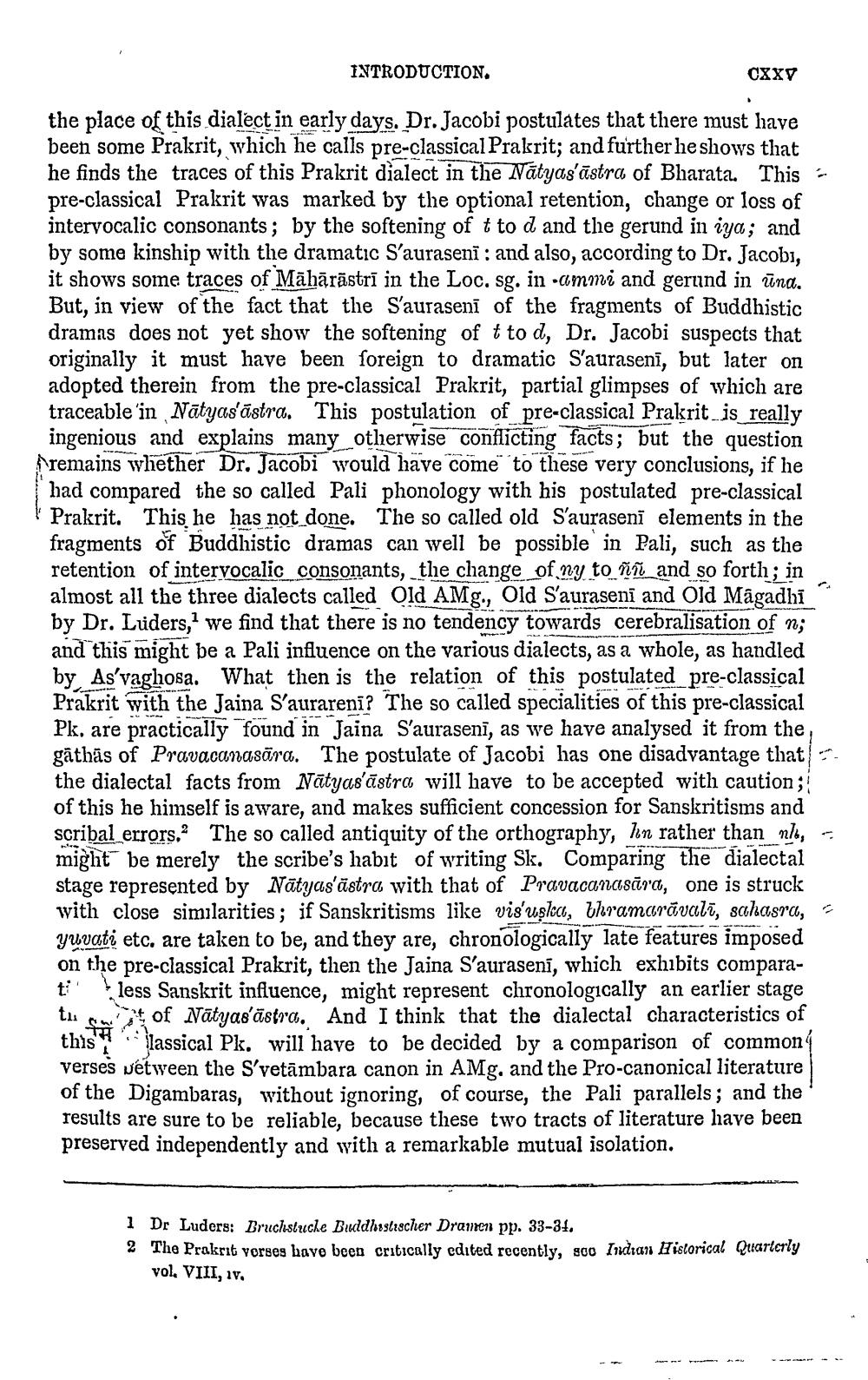________________
INTRODUCTION.
CXXY
the place of this dialect in early days. Dr. Jacobi postulates that there must have been some Prakrit, which he calls pre-classical Prakrit; and further he shows that he finds the traces of this Prakrit dialect in the Nātyas'āstra of Bharata. This pre-classical Prakrit was marked by the optional retention, change or loss of intervocalic consonants; by the softening of t to d and the gerund in iya; and by some kinship with the dramatic Sauraseni: and also, according to Dr. Jacobi, it shows some traces of Māhārāstrī in the Loc. sg. in ammi and gerund in ūna. But, in view of the fact that the Saurasenī of the fragments of Buddhistic dramas does not yet show the softening of t to d, Dr. Jacobi suspects that originally it must have been foreign to dramatic Saurasenī, but later on adopted therein from the pre-classical Prakrit, partial glimpses of which are traceable'in Nātyas'āstra. This postulation of pre-classical Prakrit is really ingenious and explains many otherwise conflicting facts; but the question Aremains whether Dr. Jacobi would have come to these very conclusions, if he had compared the so called Pali phonology with his postulated pre-classical Prakrit. This he has not done. The so called old Saurasenī elements in the fragments of Buddhistic dramas can well be possible in Pali, such as the retention of intervocalic consonants, the change of ny to ññ and so forth; in almost all the three dialects called Old AMg., Old S'auraseni and Old Magadhi by Dr. Luders, we find that there is no tendency towards cerebralisation of n; and this might be a Pali influence on the various dialects, as a whole, as handled by, As'vaghosa. What then is the relation of this postulated pre-classical Prakrit with the Jaina S'aurarenī? The so called specialities of this pre-classical Pk, are practically found in Jaina S'aurasenī, as we have analysed it from the gāthās of Pravacanasāra. The postulate of Jacobi has one disadvantage that ". the dialectal facts from Natyas'āstra will have to be accepted with caution; of this he himself is aware, and makes sufficient concession for Sanskritisms and scribal errors. The so called antiquity of the orthography, in rather than ni, might be merely the scribe's habit of writing Sk. Comparing the dialectal stage represented by Nätyas'ästra with that of Pravacanasia, one is struck with close similarities; if Sanskritisms like vis'uşlcı, Ukramarāvalī, sahasra, Yuvati etc. are taken to be, and they are, chronologically late features imposed on the pre-classical Prakrit, then the Jaina Sauraseni, which exhibits comparat less Sanskrit influence, might represent chronologically an earlier stage
of Nātyab'ästra. And I think that the dialectal characteristics of this lassical Pk. will have to be decided by a comparison of common verses wetween the S'vetāmbara canon in AMg, and the Pro-canonical literature of the Digambaras, without ignoring, of course, the Pali parallels; and the results are sure to be reliable, because these two tracts of literature have been preserved independently and with a remarkable mutual isolation.
1 Dr Luders: Bruchstuche Buddhistischer Drancn pp. 33-34. % The Prakrit vorses bave been critically edited recently, goo Indian Historical Quarterly
vol. VIII, iv,




